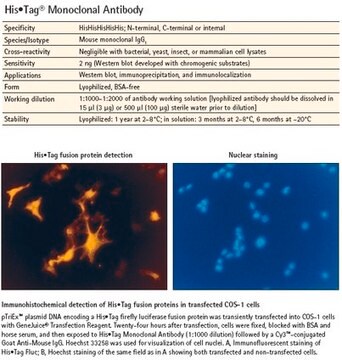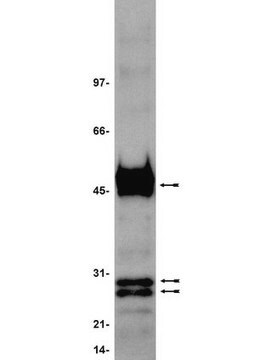SAB1305538
MONOCLONAL ANTI-HIS TAG antibody produced in mouse
clone 6AT18, IgG fraction of antiserum, buffered aqueous solution
Synonym(s):
Mouse Anti-Hexa Histidine tag
Sign Into View Organizational & Contract Pricing
All Photos(1)
About This Item
UNSPSC Code:
12352203
NACRES:
NA.43
Recommended Products
biological source
mouse
Quality Level
antibody form
IgG fraction of antiserum
antibody product type
primary antibodies
clone
6AT18, monoclonal
form
buffered aqueous solution
technique(s)
western blot: 1:1000
isotype
IgG1
shipped in
wet ice
storage temp.
−20°C
target post-translational modification
unmodified
General description
Epitope tags consisting of short sequences recognized by well-characterized monoclonal antibodies have been widely used in the study of protein expression in various systems. The 6xHIS tag (HHHHHH), recognized by the monoclonal antibody clone 6AT18 provides an established example of this application. 6xHIS-tagged fusion proteins are easily purified from cell lysates by affinity chromatography using Nickel-Sepharose resin. Abgent′s anti-6xHIS monoclonal antibody provides a simple solution to detect the expression of HIS-tagged fusion proteins in cells.
Immunogen
Purified recombinant HIS-tagged fusion protein and poly-HIS peptide were used to produced this monoclonal antibody.
Physical form
Supplied in PBS with 0.09% (W/V) sodium azide
Disclaimer
Unless otherwise stated in our catalog or other company documentation accompanying the product(s), our products are intended for research use only and are not to be used for any other purpose, which includes but is not limited to, unauthorized commercial uses, in vitro diagnostic uses, ex vivo or in vivo therapeutic uses or any type of consumption or application to humans or animals.
Not finding the right product?
Try our Product Selector Tool.
Storage Class Code
10 - Combustible liquids
Flash Point(F)
Not applicable
Flash Point(C)
Not applicable
Certificates of Analysis (COA)
Search for Certificates of Analysis (COA) by entering the products Lot/Batch Number. Lot and Batch Numbers can be found on a product’s label following the words ‘Lot’ or ‘Batch’.
Already Own This Product?
Find documentation for the products that you have recently purchased in the Document Library.
Customers Also Viewed
Jenifer E Shattuck et al.
Nature communications, 10(1), 3614-3614 (2019-08-11)
Stress granules are membraneless protein- and mRNA-rich organelles that form in response to perturbations in environmental conditions. Stress granule formation is reversible, and persistent stress granules have been implicated in a variety of neurodegenerative disorders, including amyotrophic lateral sclerosis. However
Jialing Bao et al.
Frontiers in cellular and infection microbiology, 11, 694957-694957 (2021-06-08)
Microsporidia are a group of spore-forming, fungus-related pathogens that can infect both invertebrates and vertebrates including humans. The primary infection site is usually digestive tract, but systemic infections occur as well and cause damages to organs such as lung, brain
Pooja Yadav et al.
Retrovirology, 16(1), 12-12 (2019-05-01)
The different interactions between viral proteins and cellular host proteins are required for efficient replication of HIV-1. Various reports implicated host cellular proteins as a key factor that either interact directly with HIV-1 integrase (IN) or get involved in the
Jingjing Jiang et al.
The Plant cell, 31(6), 1308-1327 (2019-04-10)
A key characteristic of chloroplast gene expression is the predominance of posttranscriptional control via numerous nucleus-encoded RNA binding factors. Here, we explored the essential roles of the S1-domain-containing protein photosynthetic electron transfer B (petB)/ petD Stabilizing Factor (BSF) in the
Fumin Shi et al.
Cell reports, 37(3), 109834-109834 (2021-10-24)
WNTs play key roles in development and disease, signaling through Frizzled (FZD) seven-pass transmembrane receptors and numerous co-receptors including ROR and RYK family receptor tyrosine kinases (RTKs). We describe crystal structures and WNT-binding characteristics of extracellular regions from the Drosophila
Our team of scientists has experience in all areas of research including Life Science, Material Science, Chemical Synthesis, Chromatography, Analytical and many others.
Contact Technical Service












